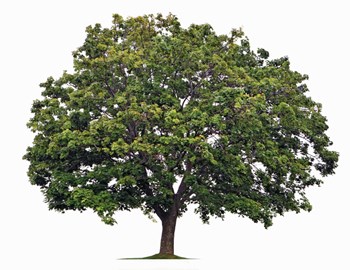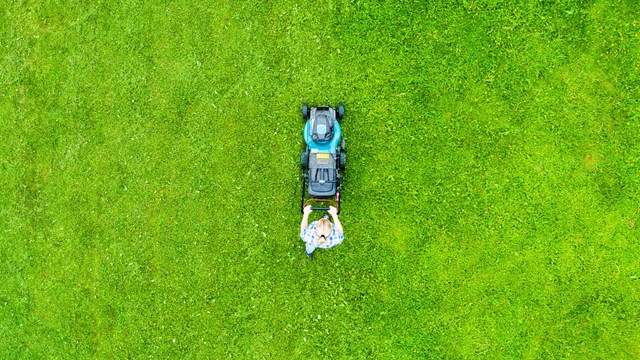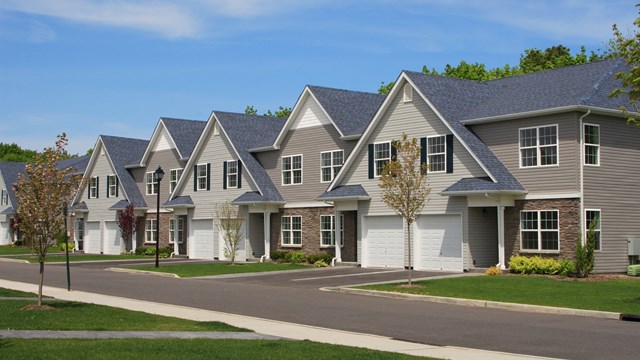
The trees that grace the outdoor spaces of most New Jersey HOAs provide more than just shade. Besides being integral parts of the landscape design, they enhance the community's overall aesthetic, which in turn increases value. Keeping your trees healthy and attractive is an important component of any association's grounds-keeping program—so what happens if your lovely spring-flowering pear trees have lost branches over a harsh winter? What do you do when those once-trim blue spruces are suddenly looking scraggly and unkempt? Ailing trees devalue a community, both by transmitting a negative message to residents and by eroding the community's curb appeal to prospective buyers.
Too Close for Comfort
Any number of ailments and accidents can befall trees in our area, but there are a few common problems that arborists and other tree care professionals see over and over again. The main culprits are improper placement and improper maintenance.
One way that trees can be damaged is when they are planted to close to condo foundations. “It’s horrendous, especially in multifamily, multi-home communities where there is a limited amount of planting space,” says Sam deTuro, chairman and founder of Woodwinds Associates, Inc. in Princeton. In many communities, deTuro continues, “Trees are planted too close to one another and too close to the structures, whether it be the buildings the sidewalks or the streets. It's the wrong tree in the wrong location.”
Badly placed trees cause trouble in several ways—their branches can interfere with power lines, or grow to obscure windows. Their falling leaves or seed pods may occlude gutters, drains, and ventilation elements. Invasive root systems can buckle sidewalks, and even in some cases work their way through foundations, wreaking structural havoc and costing thousands to repair. Trees planted too closely together can become tangled and entwined with each other, blocking out sunlight to other ground-dwelling plants and creating a maintenance headache when it comes to maintenance.
There are a number of ways that closely-packed trees can be dealt with, says deTuro. The easiest solution, he says, is “to continually prune the tree, which is often the very easy fix.” Another method that involves slowing or stopping expansion is the application of plant growth regulators, which must be used every three years or so. “Growth regulators can be successfully used if you can catch the tree before if outgrows the location,” deTuro says, “whether it be too close to a building or power line.” The most radical solution involves “Cutting down the [offending] tree down and putting in the right tree” whose roots won’t invade nearby structures, he says.
The Right Tree, the Right Maintenance
But what exactly is the “right” tree? According to Scott Lamm, a senior arborist with Sav-A-Tree in Central New Jersey, one key consideration when calculating the right tree for the right location is whether the tree will be a “street tree,” alongside a heavily traveled road and subject to conditions like car exhaust and fumes, or a tree that will be placed more off the beaten track, with plenty of clean air and fewer stress factors. Lamm recommends Hornbeam as a good all-around street tree. In addition to being tolerant of exhaust fumes, Lamm notes “They don’t get very large, so they won’t interfere with power lines and things of that nature.” Also recommended by Lamm for use along streets are flowering trees, like purple leaf plums or even the Kwanzan cherry.
When working with condo boards, Lamm says another big mistake he encounters is the “lack of consideration given to maintenance programs. Regular maintenance‚—meaning insect and disease control and fertilization.”
Lamm notes that more condos are bringing in more landscape architects who are doing a good job working with certified arborist and “they’re putting together a pretty good design package.” But, Lamm warns, condos are still “not considering aftercare.” Aftercare consists mainly of fertilization of trees by injection, says Lamm, and application of anti-fungals that ward off predators like cedar apple rust.
Because condos aren’t focused on plant maintenance, they could be losing a lot of money, says Lamm. “Just as you maintain your automobile by changing your oil and rotating your tires, you want to provide the same type of ongoing necessary care to that landscaping that was a significant investment. And you want to get as many years out of it as you can.”
One way that condo boards can save money and get more out of their landscaping is by rotating their preventive maintenance over three, four or even more years for different sections of the property, says Lamm. Instead of pruning all the trees every year, Lamm says, “I've even gone longer than four years, to five or six years’ rotation on pruning. It’s very doable.”
Tree Trends Encouraged “Invasives”
Over the years, landscape designers have experimented with numerous imported species that rose in popularity but eventually fell from grace when they were found to be invasive or not well suited to New Jersey’s climate. A number of years ago, deTuro recalls, a “there was a variety of poplar which was being sold and promoted by the garden magazines, an Asian variety of poplar. It was so bad that it's not being grown or marketed anymore.”
Another big mistake was the “Bradford variety of calumny pear, which unfortunately was used in abundance. It was a great tree, but unfortunately, as it matured it developed very weak crotches, stems branching out from the main tree,” says deTuro, who notes improved versions of the non-invasive tree have been developed.
Another mistake in New Jersey involved the ginkgo, says deTuro. The Asian import is “tolerant of exhaust fumes, tolerant of salt” but gardeners have had “difficulty determining the gender” of the plant, he notes. “The fruit of the female after it matures is the most noxious, disgusting smell. The odor is horrible.”
James McGuire, president of Hartney Greymont, Inc., an arborist firm in Needham, Massachusetts, notes that over the years, many contractors planted evergreen trees and shrubs simply “because they’re cheaper,” and crowded them too close to buildings where they can cause moisture problems. He recommends using dwarf conifers and azaleas—plants that mature to only two to four feet in diameter—where space is confined. He points out that rhododendrons are very popular but can reach eight to twelve feet and often outgrow their space.
Just as bad is plopping them—or any plants—into conditions they don’t do well in. “We looked at a project,” he says, “where the clients had rhododendrons planted in full sun next to a rain downspout. Rhodies don’t like ‘wet feet’ or too much sun.” As an alternate choice in shrubs, he recommends red vein enkianthus, a spring-flowering relative of the rhododendron, because, he states, “It stays narrow at about six to eight feet.”
McGuire also warns against shearing—as is often seen in hedge-clipping—that lops off the outermost tips of branches and twigs. While this causes the external foliage to become dense, “it will eventually hollow out the interior and thin the branches from the bottom,” he notes. “You want to encourage the interior growth; to do that, you must hand-prune. Trees need periodic pruning to reduce the likelihood of breakage during storms, as well as maintaining clearance around lighting and signage… When pruning is done correctly, you can keep a plant growing forever.”
What Lies Below?
Sometimes contractors expect a quick cover of loam and seed to take the place of an actual landscaping plan. Soils are especially important but success with plantings starts even below the soil. When units and roadways are under construction, contractors often try to cover ledge with topsoil. But you need drainage. Then landscape plants eventually die or the soil erodes or washes away—not a good visual in a new development.
Landscape designers can assess topography and soils, creating a plan to accommodate ledge and rocky outcroppings, and soil adjustments can be made. The next challenge is finding species that will thrive in your particular climate and setting. “Particular” should be underscored, as deTuro notes that New Jersey has a diversity of climates. “Trees thriving in New Jersey are like people thriving in New Jersey. For such a small space, for the square footage and acreage involved, New Jersey probably has a greater variety of micro-environments and climates than any state that I've been in. Trees that thrive in Cape May may not survive along the New York State line.”
Trees that do well across New Jersey include the Japanese Zelkova, which has the shape and form of the elm and has been planted to replace many decimated by Dutch Elm disease, he says.
Other trees that have done well across the state include the “larger shade trees, some varieties of native ash, oak, the harder, slower growing maples such as the varieties of the native red maple, “ he says.
Hackberry and some locusts have done well in the southern part of the state, near the ocean and salt air, as has the linden, he says.
All the experts agree that monitoring the health of trees and landscape specimens requires an arborist with a long-term commitment, since problems are almost never evident right away. The stresses that eventually kill trees, including drought, flood, chemical dumping, insects or blight, may take years before the damage becomes obvious. A trained eye observing growth through multiple seasons can help associations keep their green investments alive and well.
Marie N. Auger is a freelance writer in Massachusetts and a frequent contributor to The New Jersey Cooperator. Additional research by Jim Douglass.






Leave a Comment